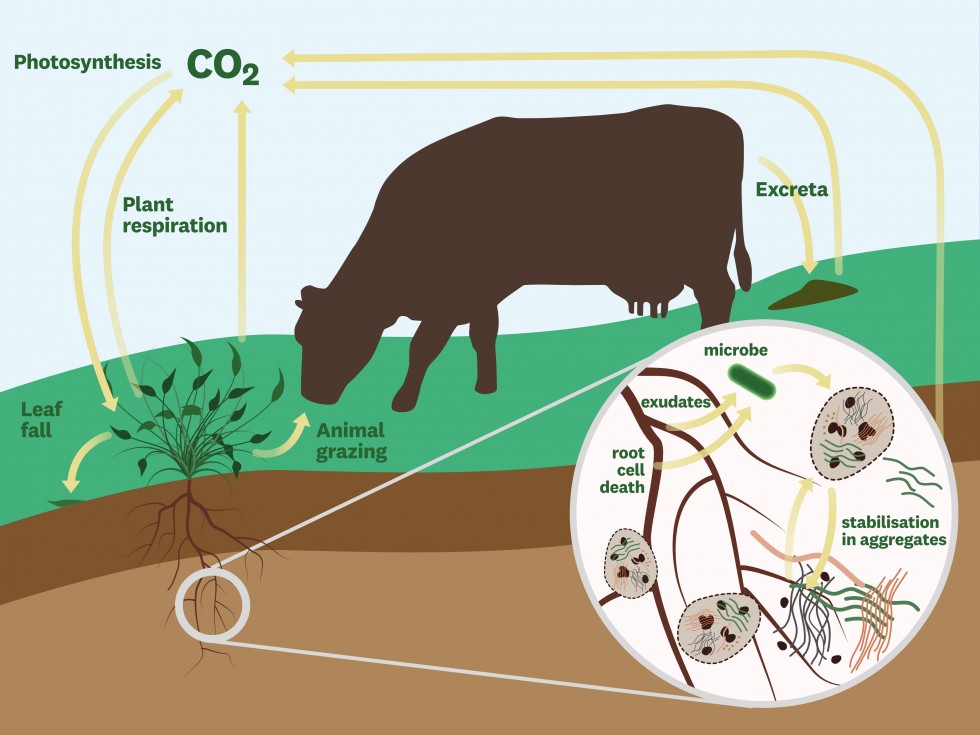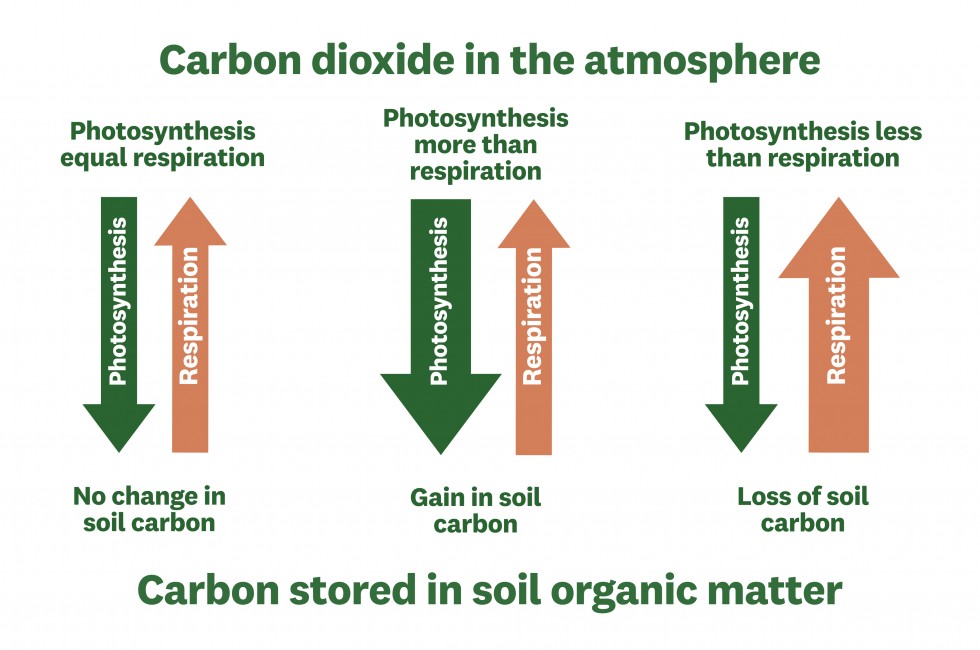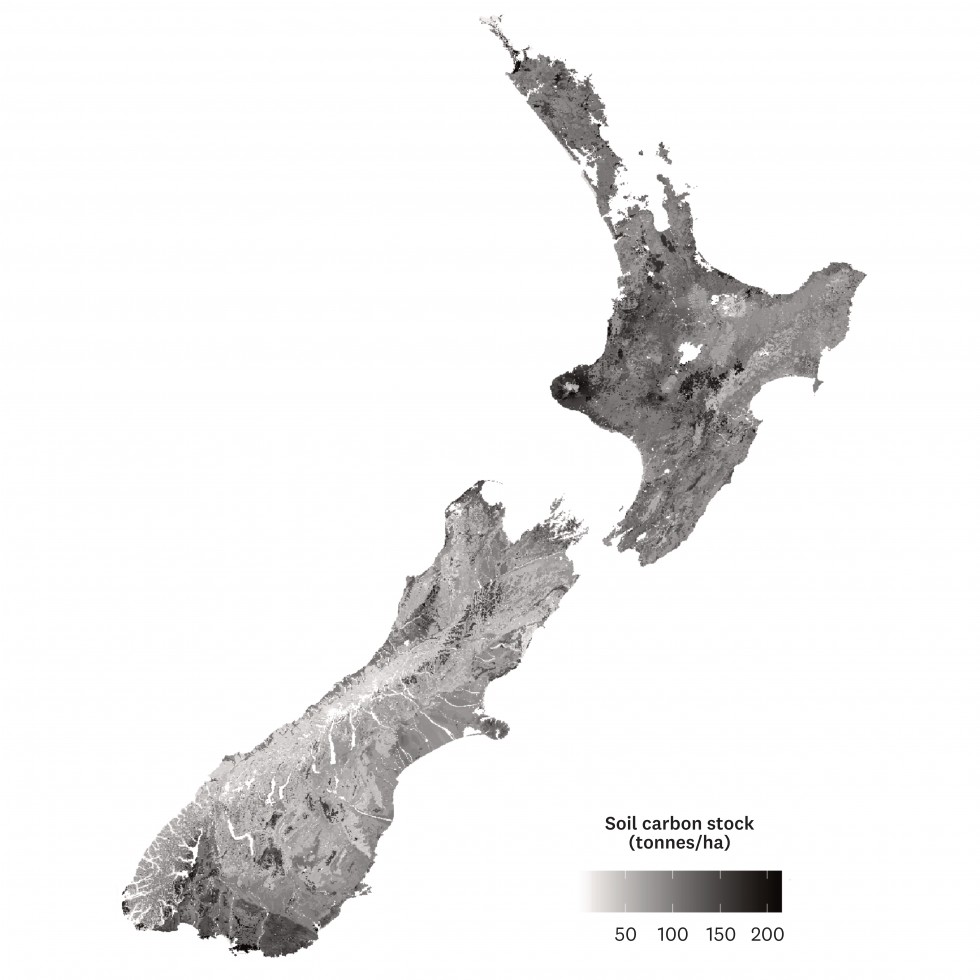Soil carbon science
A vast amount of carbon is stored in the world’s soils. Locking away more could help improve farm productivity and reduce atmospheric carbon dioxide concentrations. What is soil carbon, what influences it, and why is it hard for New Zealand farmers to verifiably increase their stocks?
What is soil carbon?
The soil is an important reservoir of carbon. Carbon dioxide is taken from the atmosphere by plants during the process of photosynthesis. Plants store some of this carbon dioxide (in the form of carbon in above- and below-ground plant parts), while much of it is lost back to the atmosphere via the process of respiration. The carbon in plants enters the soil from roots, decaying above-ground plant matter and, in livestock systems, from animal dung and urine produced when plant material is eaten.
Soil organisms such as worms, beetles and microbes actively feed on these plant-derived carbon sources and respire much of it back into the atmosphere as carbon dioxide. However, a small proportion of carbon becomes tightly bound to the mineral surfaces of soil particles or encapsulated in clumps (‘aggregates’) of soil particles. In this state, the carbon is physically protected and less accessible to microbes. It’s said to be ‘stabilised’ and can remain locked away for tens to hundreds of years.
The following diagram illustrates the carbon cycle.
Whether soil gains or loses carbon depends on the balance of photosynthesis by plants and respiration by the soil and plants, as shown in the diagram below. Photosynthesised carbon can also be exported in products like milk and later converted to carbon dioxide after being consumed.
Soil carbon is important to farmers and growers because it influences soil structure, nutrient cycling and water retention. Carbon-rich soils help support vigorous plant growth and are more resilient to stressors such as drought.
Soil carbon is also an important factor in climate change.
How does soil carbon affect climate change?
As so much carbon is locked up in soils (more than is stored above ground in plants and the atmosphere combined), small changes in soil carbon stocks could have significant effects on climate change.
Management practices that increase the amount of carbon stored in soils could help reduce the concentration of carbon dioxide in the atmosphere. On the other hand, practices that deplete soil carbon and release carbon dioxide back into the atmosphere add to other emissions of greenhouse gases.
From the perspective of current atmospheric carbon dioxide concentrations, what matters is not the total quantity of carbon stored in soils, but the magnitude of change in this quantity over time.
What influences soil carbon stocks and stock changes?
There’s high spatial variability in soil carbon stocks (even within a single paddock) and stocks can also vary with time. The biggest influences on soil carbon stocks are:
- Environmental factors (for example, climate, soil type, topography) which broadly determine the amount of carbon that can be stored in a particular soil type at a given site
- Land-use changes (for example, converting forest to pasture, pasture to crops, or vice versa)
- Different land-management practices within a land use.
There’s anecdotal evidence claiming that certain management practices within a given land use will reliably increase soil carbon stocks, but this is not backed up by rigorous scientific studies conducted under New Zealand conditions. Currently, therefore, there’s insufficient scientific evidence available to recommend individual practices that will consistently maintain or increase soil carbon stocks under different land uses and physical environments. Scientists know there are some practices that are likely to deplete soil carbon, such as leaving soils bare of growing plants for long periods. Losses of carbon also generally happen a lot faster than gains. Comprehensive research into the effects of individual management practices on soil carbon stocks is ongoing. See the Maintain or increase soil carbon goal page for more.
At the same time, a new study has begun that will benchmark soil carbon stocks around New Zealand and then monitor how they are changing with time. Data will provide a clear national-scale picture of how New Zealand’s soil carbon stocks measure up and whether those stocks are increasing or decreasing. See the Measuring soil carbon topic page for more.
What do we know now about New Zealand’s soil carbon stocks and how they’re changing?
Currently available data indicate that carbon stocks in New Zealand agricultural soils are high compared to other countries (a little over 100 tonnes per hectare in the top 30 cm), for several reasons:
- Our soils are young and human settlement has occurred comparatively recently.
- New Zealand has a temperate climate that mostly supports year-round plant growth, resulting in continuous inputs of carbon into our soils from plants.
- The chemical and physical properties of our soils mean they generally have a large capacity to protect carbon from loss.
- Our soils have generally been well managed with little intensive tillage and cropping—practices that have decreased soil carbon in many other countries.
- Most of our pastures are long-term perennial, meaning soils are rarely devoid of growing plants.
- A large proportion of our pastures are grazed by livestock, which recycle carbon in the form of dung.
From this high starting point, it’s considerably harder to add to New Zealand’s soil carbon stocks than in other countries, where more challenging environmental conditions and/or long-term intensive cropping have resulted in low baseline soil carbon stocks.
Changes in New Zealand soil carbon stocks
It’s highly uncertain whether soil carbon stocks across all of New Zealand’s managed pastures are increasing, decreasing or stable. Current evidence suggests that:
- For grazed clover/ryegrass pastures on flat-to-rolling land, soil carbon stocks did not change between around 1980 and 2010 in most soils.
- Allophanic and Gley soils have previously lost carbon, but it’s not known whether losses are ongoing.
- Drained peat soils continue to lose carbon at quite high rates.
- Some hill country grassland soils (which occupy about 4 million hectares or 38% of New Zealand’s grazed land) gained carbon at a rate of up to 0.6 tonnes/ha/year between 1980 and 2010 . However, it isn’t clear how widely spread these gains are or whether they’re ongoing.
More spatially and temporally comprehensive data are needed to better determine soil carbon trends in different physical environments, land uses and management practices. The research and benchmarking/monitoring programmes noted in What influences soil carbon and soil carbon stocks? (above) will provide some of these data.
The impact of soil erosion is also important to consider. Erosion redistributes topsoil (and any carbon it contains) around the landscape. Some carbon is buried and stabilized (for example at depth in the soil, or in lake and ocean sediments) and some is decomposed. Research by Manaaki Whenua has found that soil carbon stocks on uneroded soils average around 100t/ha but only 60-65 t/ha on sites with extensive landslide and gully erosion. Soil carbon stocks do build back up again in eroded sites, however not to the same extent as uneroded sites. Research is ongoing to understand the effect of human-induced erosion on net carbon dioxide emissions.
Right now, New Zealand pasture soils generally have high stocks that seem stable under contemporary management practices. But there’s a lack of scientific evidence about practices that increase soil carbon.
Because of the uncertainty around how New Zealand’s soil carbon stocks are changing within any land use, and how changes are influenced by specific management practices, New Zealand’s national greenhouse gas inventory does not currently account for changes in soil stocks within a land use. Reporting is limited to accounting for soil carbon stock changes when land use is changed, for example from arable to pasture. You can read more about this type of soil carbon accounting on the Ministry for the Environment website.
More information
For more on the science of soil carbon, see:
- Sarah's Country podcast on soil carbon with Professor Louis Schipper, 30 September 2020
- Farmers Weekly article 28 September 2020: Soil carbon influences climate as well as soil productivity
- NZAGRC factsheet on soil carbon
- NZIPIM soil carbon webinar
- Manaaki Whenua Landcare Research National soil carbon modelling and map
- RNZ Nights, podcast on soil carbon
- Soil carbon presentation at the 2019 NZ Agricultural Climate Change Conference presentation
- ‘Looking after your soil carbon’, article in DairyNZ Technical Series 2017




